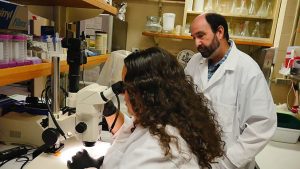As a child growing up on Hawaiʻi Island, Narrissa Spies thought the classroom and beach were two separate and distinct places. Today, this 35-year-old graduate student in zoology at the University of Hawaiʻi at Mānoa knows that protecting coral reefs is both her future job and life’s passion.
“I grew up in a house that didn’t have electricity, so for us going to the beach during the day was an amazing way to escape,” said Spies. “I didn’t realize as a child that I could do those types of things as a career, that I could investigate sea creatures, turn over rocks, as my job.”
Thanks to a $45,000 fellowship from the Kohala Center, a Waimea-based nonprofit, Spies is spending the 2017–18 academic year finishing her doctorate on how coral are able to withstand multiple stressors resulting from human activities.
Bob Richmond, her faculty advisor and director of the Kewalo Marine Lab, says Spies is more than a brilliant scientist: She is a cultural practitioner who will inspire future ocean researchers.
“For many scientists, the coin of the realm is the peer-reviewed publication. They say, ‘Okay, my job is done, I’ve published the paper,‘” said Richmond. “For Narrissa and her generation, that is no longer sufficient. ‘We’ve done the science, we’ve published the paper and now we have to put that knowledge to work.’ And that’s what distinguishes her from a lot of other people.”
Spies grew up in Hilo and Kawaihae, where her childhood aspiration was to become a medical researcher. She began her studies at Hawaiʻi Community College, graduating from UH Hilo with a bachelor of arts in biology and anthropology, and a master’s degree in tropical conservation biology and environmental science.
Today, you’ll find Spies at the Kewalo Marine Lab, near Kakaʻako Waterfront Park, where she is on schedule to earn a doctorate in zoology in Spring 2018. She continues her research after receiving yet another honor—a grant from the National Oceanic and Atmospheric Administration to engage high school students in the natural sciences as a career path.
By demonstrating her high level of success, this role model will increase the number of Native Hawaiian professionals with a cultural affinity for protecting fragile natural resources.
“I feel it’s important to educate students in STEM (Science, Technology, Engineering and Math) because these are our resources in Hawaiʻi,” said Spies. “And who better to care for these resources than people who grew up here, and can understand how important they are to our local community.”


